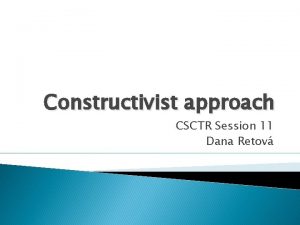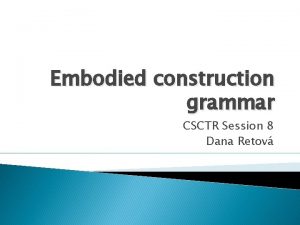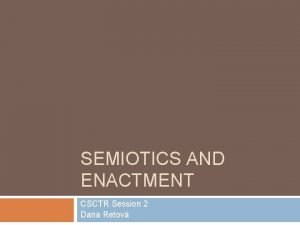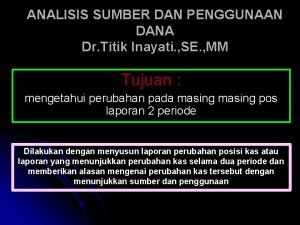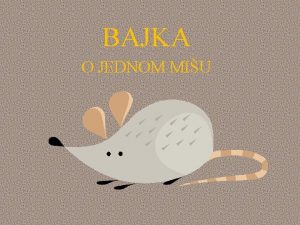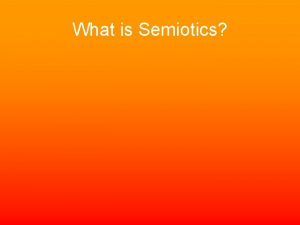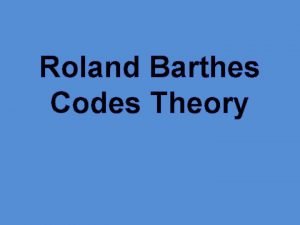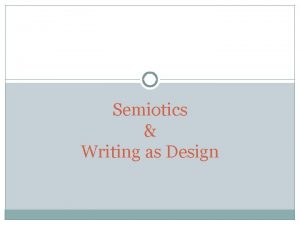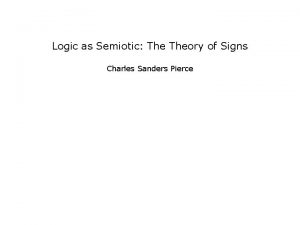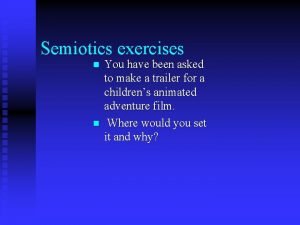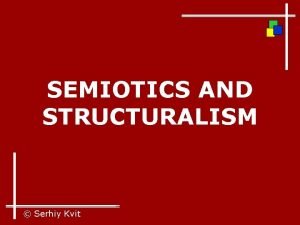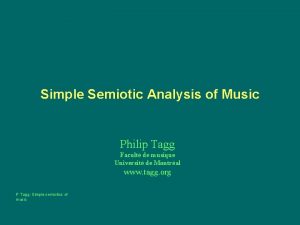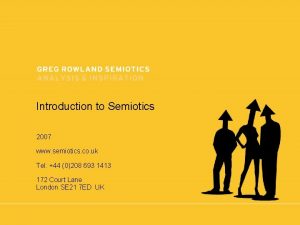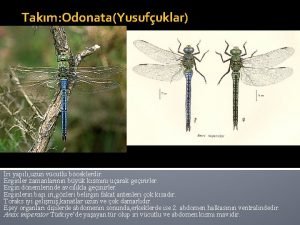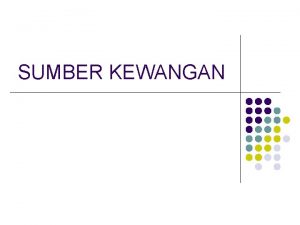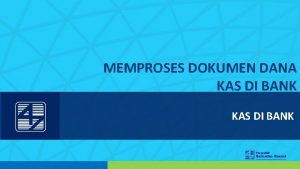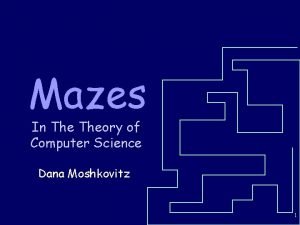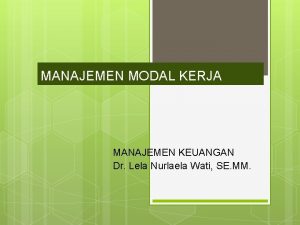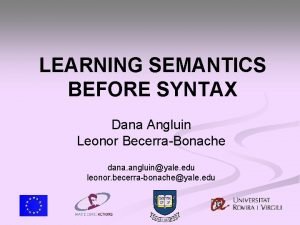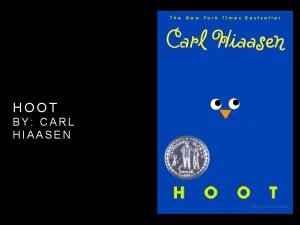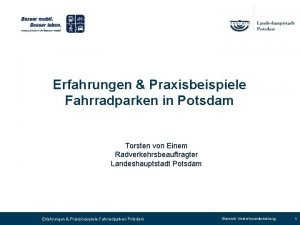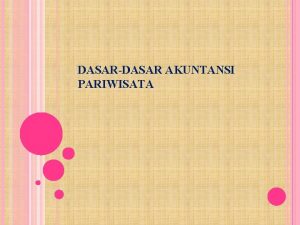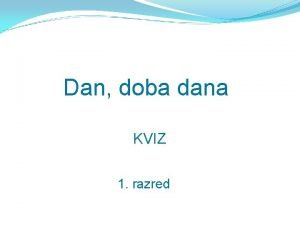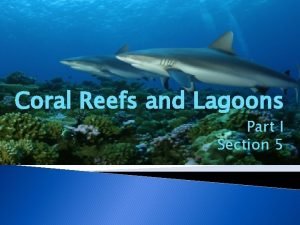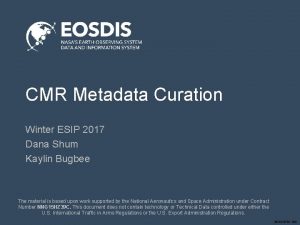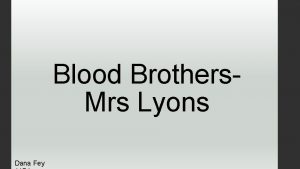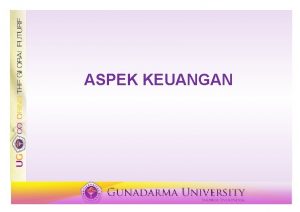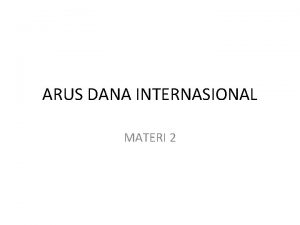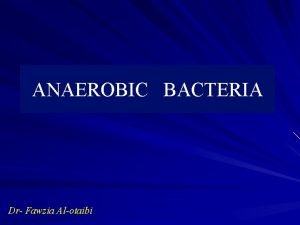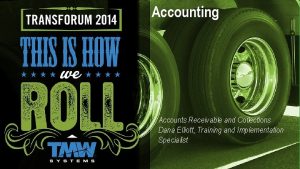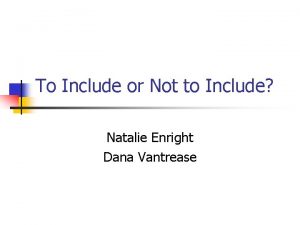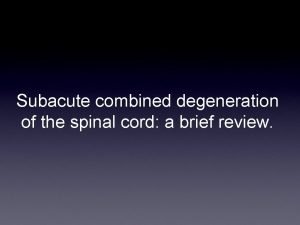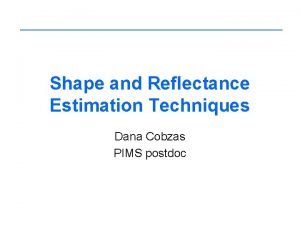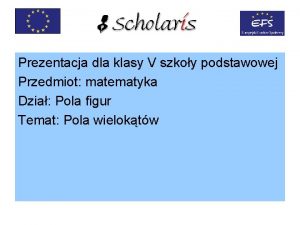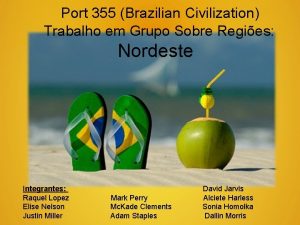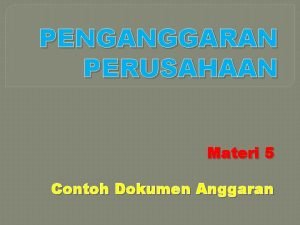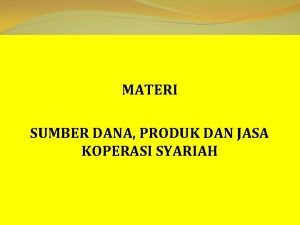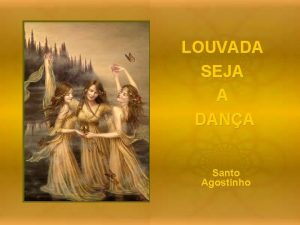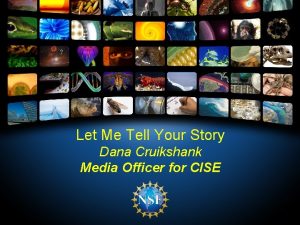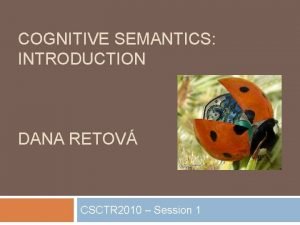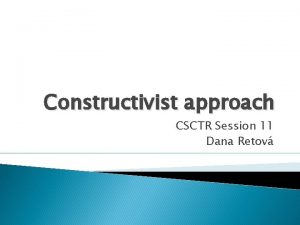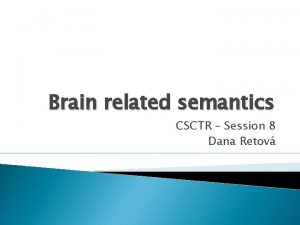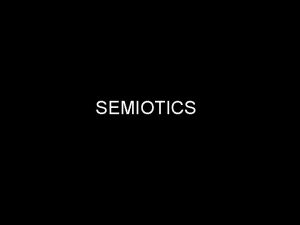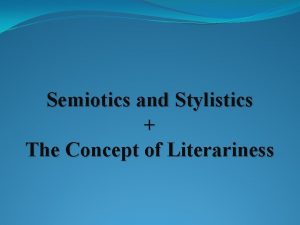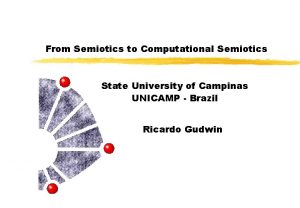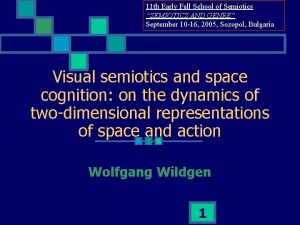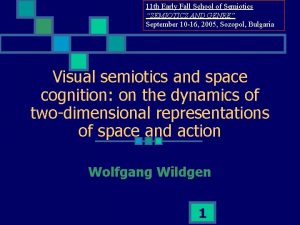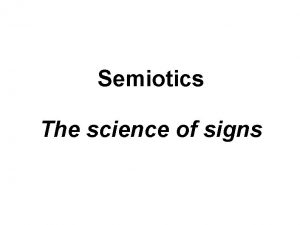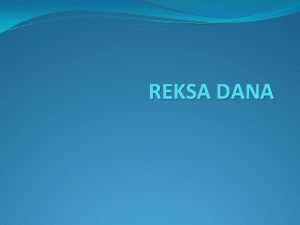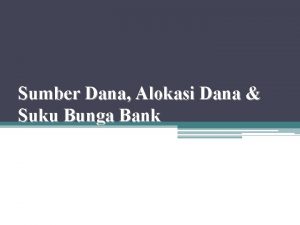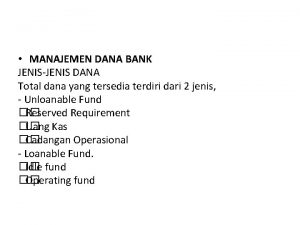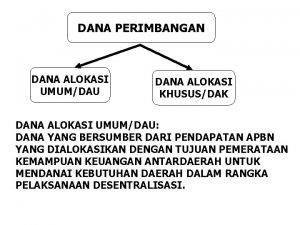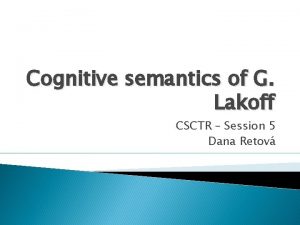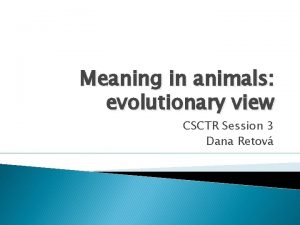SEMIOTICS AND ENACTMENT CSCTR Session 2 Dana Retov












































![Organizational closure [Systems exhibit organizational closure if. . . ] ". . . their Organizational closure [Systems exhibit organizational closure if. . . ] ". . . their](https://slidetodoc.com/presentation_image/6b5719249a4766121c606916f958a138/image-45.jpg)








- Slides: 53

SEMIOTICS AND ENACTMENT CSCTR Session 2 Dana Retová

Meaning in organisms Discontent about anthropomorphic explanations � After Darwin – breakdown of the distinction between humans and other species => attribution of human-like mental qualities to other vertebrates. � Explaining the behavioral unity of organisms, and their environmental embedding, based on their biology Mechanistic (Loeb) Umwelt (Uexkull)

Mechanistic theories Loeb (1918) – theory of tropisms (directed movement towards or away from stimuli) � Geotropism � Phototropism

Jakob Johann von Uexküll (18641944) Shift away from mechanistic or anthropocentric views Biology as epistemology focus on meaningful responses which enable every organism to actively realise its own life-world — it’s unique Umwelt. based on empirical physiological studies of the movements of invertebrate animals

Jakob Johann von Uexküll Biology should study organisms not as objects, but as active subjects. Umwelt = subjective world of an organism individual organism is always actively creating it’s individual Umwelt this creative process is related to meanings determined by the animal’s � internal � needs � design � etc. states

Negative feedback “nervous excitation always flows towards the stretched muscles” activity of the nervous system facilitates the contraction of stretched muscles and thereby counteracts and regulates the stretching of muscles Little diagrams in the text illustrating a description of feedback and reafferent control (Uexküll 1920: 201).

Negative feedback Negative feedback occurs when the output of a system acts to oppose changes to the input of the system The result is that the changes are attenuated (weakened) In contrast, positive feedback is a feedback in which the system responds in the same direction as the perturbation, resulting in amplification of the original signal instead of stabilizing the signal. A positive feedback of 100% or greater will result in a runaway situation. Both positive and negative feedback require a feedback loop to operate.

Why is reflex arc an example of negative feedback? There are muscle length sensory receptors in the quadriceps muscle. When the patellar tendon is tapped, it causes a stretch in the quads, which stimulates the length receptors. This fires an action potential in the sensory neuron, which goes to the spinal cord, where it innervates the motor neuron to the same muscle. Assuming the stimulus was strong enough, the motor neuron also fires an action potential, and causes a contraction in the quads, resulting in a slight kick of the lower leg. Thus, the reflex arc is an example of negative feedback. • Functional circle an example of negative feedback

Umwelt and negative feedback Umwelt - formed by perceptual and effector worlds together Organism is embedded in the world through functional cycles modeling of functional cycles should help to conceptualise the functional organisation of behaviour as an ongoing process of regulation

Umwelt of a tick Tick: 3 successive reflexes: 1. 2. 3. Butyric acid as perceptual cue – tic let go and drops Tactile cue of hair – move around Skin’s heat – suck

Functional circle – receptor and effector cues

Umwelt Out of hundreds of stimuli radiating from the qualities of the mammal’s body, only 3 become the bearers of receptor cues. The whole rich world around the tick shrinks to 3 receptor cues and 3 effector cues – her Umwelt

Semiotic triangle (Pierce) signs Representamen (form) -does not necessarily exist as an abstract entity e. g. “a mammal” - Might only have temporary existence as different semiotic objects and the bearer of varying meanings. Behavioral disposition ? Interpretant (meaning) Object (referent)

Umweltforschung T. von Uexküll: “The approach of Umweltforschung aims to reconstruct creative nature’s process of creation” Sensory physiology - investigation of the capacity of the sense organs � Investigating the animal’s ability to perceive and discriminate different physical stimuli � First ideas about the signs that possibly constitute the animal’s Umwelt.

Illustrations of the different visual Umwelten of a human, a fly and a mussel (Uexküll, Brock 1927).

Lißmann (1932) • Use of fish dummy to identify the physical features that function as signs of rivalry • counted the attacks that were elicited by dummies with different body marks. • their significance as signs (Merkzeichen) in the functional cycle of rivalry Diagram showing the frequency of aggressive reactions to dummies with different signal cues (Lißmann 1932: 89).

Hermit crab & sea anemone Friedrich Brock (1927) investigated the complex interplay necessary before the crab could find the right anemone, induce it to leave its place and let itself be planted onto the crab’s shell, where it would serve as protector against octopuses, while the anemone would profit from the leftovers of the crabs meals

The interaction of the hermit crab and the sea anemone, changing according to change in meaning (Uexküll, Kriszat 1934: 55).

Change of meaning of the sea anemone to the hermit crab (1) Upper row: if the crab inhabits snail shell without an anemone, an anemone is seen as a welcome partner for symbiosis. The anemone is “hugged” and forcefully persuaded by rhythmic drumming to loosen its hold and then put upon the crab’s house. (2) Middle row: if the crab is naked it will try to use the anemone as substitute for the protecting shell. (3) Lower row: if the crab is already in symbiosis with anemones, then it interprets the appearance of another anemone as a welcome prey and starts to feed on the animal. � The perceived signs are marked with different meanings: depending on the subject’s needs they are either made a part of the protection functional cycle or

Dogs, human language and the effect world (Wirkwelt) Emanuel Sarris (1931), “Sind wir berechtigt vom Wortverständnis des Hundes zu sprechen” (“Can we talk about the dog’s understanding of words”) trained his dogs to react to command sentences in German and Greek. � tried to show that dogs understand the meaning of words. � The dogs jumped on a chair, when he said “chair”. they would also jump on a sofa or small table Sarris stated that dogs could indeed recognise words out of a mixture of sounds and assign meaning to them. “But the understanding of words by the dog is always appropriate to the dog’s Umwelt”

The different Wirkwelten (effect worlds) of a human, a dog and a fly (Uexküll, Kriszat 1934: 56– 58).

Meaning and AI Craik (1943): Organisms make use of explicit knowledge or world models � Internal representations of external world � If the organism carries a “small-scale model” of external reality and of its own possible action, it is able to try out various alternatives Conclude which is the best React to future situations before they arise Utilize knowledge from the past dealing with present and future � Didn’t specify the nature of this model


Classical AI Representation as internal mirror of an observer-independent, pre-given external reality No causal connections between the internal symbols and the external world � Lack of intentionality � No receptors and effectors Connection between representational domain and represented world is really just in the eye of the designer or other observers (see next figure)


AI and semiosis Semiosis: “a sign-process, that is, a process in which something is a sign to some organism” (Morris, 1946) Signs are “of prime importance in all aspects of life processes” (T. von Uexkull, 1992) Organisms = autonomous subjects Inorganic mechanisms = heteronomous � Lack “first hand semantics” / “intrinsic meaning” (Harnard 1990) � Are not autopoetic (self-creating and maintaining)

AI and semiosis All action is a mapping between individual stimuli and effects, depending on a historically created basis of reaction – a context-dependent behavioral disposition Mechanisms do not have such a historical basis of reaction, which can only be grown � There is no growth in machines � When they get damaged, they cannot repair or regenerate “Machines act according to plans (of their designers), whereas organisms are acting plans. (von Uexkull 1928) Centrifugal vs. centripetal plan

Autonomous agents Much current research in AI and Alife Typically robotic systems Situated in some environment � Interacting with it using sensors and motors � Self-organizing � � They learn, develop and evolve (using NN or evolutionary algorithms) Bottom-up design Also called artificial organisms, animats, creatures, biorobots. Physical / virtual ? Are they autonomous? Are they capable of semiosis?

Early examples of artificial organisms Grey Walter - tortoises � http: //www. youtube. com/watch? v=l. LULRlm. Xk. Ko � 2 sense reflexes Photoelectric cell (light) Electrical contact (touch) � Attracted toward moderate light sources � Repelled by obstacles, bright light, steep gradients � Attracted to bright light only when needed recharging

Self-organizing systems Learn, develop, evolve as a result of adaptation in interaction with an environment Often not even interpretable to humans Their representations are private, only meaningful to themselves Embodied autonomous systems � Modeled as embedded in their environments by means of functional circles � Intelligent behavior – outcome of a continual interaction between organism and environment

Situatedness and embodiment (Brooks, 1991) “The robots are situated in the world – they do not deal with abstract descriptions, but with the here and now of the world directly influencing the behavior of the system. ” “The robots have bodies and experience the world directly – their actions are part of a dynamic with the world and have immediate feedback on their own sensations”.

Robot’s own Merkwelt AI program might have an internal representation describing chairs as something one could sit on. That might be appropriate for human but entirely meaningless to a computer or a wheeled robot which could not possibly sit down or climb on top of a chair.

Subsumption architecture Functional circles in hierarchy – different behavioral modules E. g. robot avoiding obstacles 1. 2. 3. Forward motion (default) Turning when obstacle detected Turning towards light when detected Criticism: does not allow for learning � � Operationally autonomous But still heteronomous – interaction still predetermined by a designer

Different adaptation techniques Artificial neural networks (ANNs) Artificial nervous systems -ANNs used as robot controlers � Recurrent ANNs � Mapping from input to output varies with the network’s internal state Reinforcement learning – occasional feedback � mapping a robot’s sensory inputs to motor outputs It is impossible to tell a child learning to ride a bike how exactly to move its legs and body. Evolutionary adaptations http: //www. youtube. com/watch? v=Skvp. Ef. APXn 4&feat ure=fvw Co-evolutionary methods: http: //www. youtube. com/watch? v=Liz. WAh. WUFSI&feat ure=related

Self-organized communication Cangelosi & Parisi (1998) � Mushroom world Steels & Vogt (1997) � Adaptive language games

Difference between artificial nervous systems and mechanisms They adapt Although they don’t “grow” they do have “historical basis of reaction” Do not react in a purely physical or mechanical manner to causal impulses Their reaction carries a “subjective” quality Make use of “signs” that are meaningful for them – epistemic autonomy Controllers developed according to centrifugal principles

Difference between living and artificial Autopoesis Enactment Autonomy Self-maintenance Self-modification Francesco Varela (1946 -2001) Humberto Maturana (1928)

Maturana & Varela Cognition – not representation of the world “out there”, but rather an ongoing bringing forth of a world through the process of living itself” Cognitive self is “the manner in which the organism, through its own self-produced activity, becomes a distinct entity in space, though always coupled to its corresponding environment…” Living organisms consist of autopoietic unities � Self-producing/maintaining systems

Autopoietic and allopoietic systems Autopoiesis: literally means "auto (self)creation" Autopoietic system – its components are produced by the interaction and transformation of themselves, they continuously regenerate and realize the network processes Allopoetic system – its components are produced by other processes that are independent of the organization of the machine. Similar to Uexkull’s centripetal/centrifugal distinction

Autopoiesis and living cell System creates and maintains itself System creates its own border

Autonomy Autonomous systems - composite unity by a network of interactions of components that 1. 2. through their interactions recursively regenerate the network of interactions that produced them, and realize the network as a unity in the space in which the components exist by constituting and specifying the unity's boundaries as a cleavage from the background. . . " (Varela, 1981, p. 15) The difference between autonomy and autopoiesis is that autopoietic systems must produce their own

Structural coupling "In general, when two or more plastic dynamic systems interact recursively under conditions in which their identities are maintained, the process of structural coupling takes place as a process of reciprocal selection of congruent paths of structural changes in the interacting systems which result in the continuous selection in them of congruent dynamics of state. " (Maturana & Guiloff, 1980, p. 139)

Structural coupling Ontogeny is the history of structural change in a unity without loss of its organization. This structural change is � Triggered by interactions coming from environment � Result of it internal dynamics The result is mutual congruent structural changes => STRUCTURAL COUPLING

Autopoietic unities First-order � autonomous Second-order � multicellular unities / metacelular unities Third-order? � societies? How about organs? � Liver, heart, …
![Organizational closure Systems exhibit organizational closure if their Organizational closure [Systems exhibit organizational closure if. . . ] ". . . their](https://slidetodoc.com/presentation_image/6b5719249a4766121c606916f958a138/image-45.jpg)
Organizational closure [Systems exhibit organizational closure if. . . ] ". . . their organization is characterized by processes such that � the processes are related as a network, so that they recursively depend on each other in the generation and realization of the processes themselves, and � they constitute the system as a unity recognizable in the space (domain) in which the processes exist. " (Varela, 1979, p. 55)

Organizational closure of embodied systems

Enactive cognitive science Generalisation of autopoiesis on other living organisms – multicellulars and societies Enactive cognition – self-creation and selfmaintenance. Cognition equals to processes in living body Cognition is always embodied

Another approach to evolution L. Kováč (2003): Human consciousness as a product of evolutionary escalation of emotional selection (in Slovak) � Suggests 3 types of creative evolutionary mechanisms: Retrograde D -> E -> F F F A -> B -> Y -> Z Z Z A A -> B B -> C Intercalary Initial state State 2 State 3 Inventive Initial state State 2 State 3

Intercalation Most simple cognitive systems: � Moleculary cognition After reception of a signal, molecular receptor changes its conformation – can be viewed as molecular action (of transmitting the signal to other molecule). � Intracellular cognition E. coli – registers attractants or repellents in its environment and reacts by moving towards or away from stimuli. � Intercellular Sensors cognition and effectors are 2 different cells with intercalated nerve cells in between

Intercellular cognition • Interneuron modulates the outcome according to the state of inner environment • Sensory information, primarily evaluated by the sensor is secondarily evaluated on a higher level • Past experience contributes to this evaluation • Also information from other sensors contributes This kind of secondary processing of signal, refining of the evaluation by the receptor is in fact PERCEPTION

Perception is intercalated

Held & Hein (1963)

What is living has never been dead ~ Raymond Ruyer
 Csctr
Csctr Csctr
Csctr Csctr
Csctr Sabah water resources enactment 1998
Sabah water resources enactment 1998 Filipino dramatization of the life of jesus christ.
Filipino dramatization of the life of jesus christ. Contoh analisis sumber dan penggunaan dana
Contoh analisis sumber dan penggunaan dana Jednog dana ili jednoga dana
Jednog dana ili jednoga dana Peirce semiotics
Peirce semiotics Barthes enigma code
Barthes enigma code Semiotic myth
Semiotic myth Eyeline
Eyeline Semiotics
Semiotics Semiotics
Semiotics Semiotics
Semiotics Semiotics exercise
Semiotics exercise Semiotics
Semiotics Philip tagg
Philip tagg Greg rowland semiotics
Greg rowland semiotics Danaburnu böceği
Danaburnu böceği Sumber kewangan kelab dan persatuan
Sumber kewangan kelab dan persatuan Dana foglesong
Dana foglesong Memproses dokumen dana kas kecil
Memproses dokumen dana kas kecil Dana moshkovitz
Dana moshkovitz Contoh soal metode keterikatan dana
Contoh soal metode keterikatan dana Cara pemenuhan kebutuhan modal
Cara pemenuhan kebutuhan modal Manajemen perbankan adalah
Manajemen perbankan adalah Dana angluin
Dana angluin Hoot mullet fingers real name
Hoot mullet fingers real name Dana fiebig
Dana fiebig Dana ryan lenovo
Dana ryan lenovo Pt doremi menyimpan dananya di bank dana asia
Pt doremi menyimpan dananya di bank dana asia Pengertian akuntansi dana
Pengertian akuntansi dana Dan doba dana 1 razred
Dan doba dana 1 razred Darwin-dana-daly theory of atoll formation
Darwin-dana-daly theory of atoll formation Sex dana alotaibi
Sex dana alotaibi Dana shum
Dana shum Dana fey
Dana fey Kebutuhan dana adalah
Kebutuhan dana adalah Arus dana internasional adalah
Arus dana internasional adalah Potent defenition
Potent defenition Dana elliott
Dana elliott Natalie dana enright jerger
Natalie dana enright jerger Lichtheim's disease
Lichtheim's disease Dana cagen
Dana cagen Dana cobzas
Dana cobzas Dana buys dress shirts from a clothing manufacturer
Dana buys dress shirts from a clothing manufacturer Pole prostokątnej działki o wymiarach 50 m i 30 m wynosi
Pole prostokątnej działki o wymiarach 50 m i 30 m wynosi Dana safona
Dana safona Dnevni tipovi
Dnevni tipovi Contoh anggaran dan penganggaran
Contoh anggaran dan penganggaran Sumber dana koperasi syariah
Sumber dana koperasi syariah Santo agostinho dança
Santo agostinho dança Dana cruikshank
Dana cruikshank Jenis jenis panjar
Jenis jenis panjar
